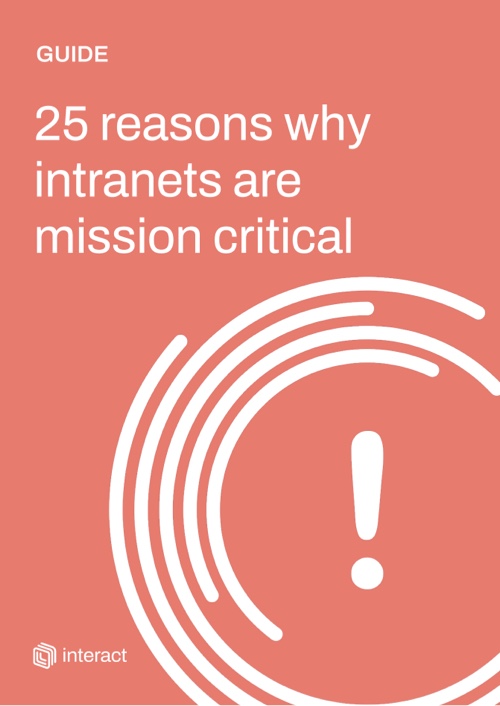Pre-boarding: the pre-first day DEX you’re probably missing out on

It’s an important feature of the employee lifecycle. So why are so many businesses missing out on a pre-boarding experience?
Our Head of Customer Insights, Nigel Williams, spoke at the Step Two DEX Conference in Sydney recently. As a specialist in customer experiences within the digital workplace, he focused upon pre-boarding and its impact on a number of business advantages, including staff retention and employee satisfaction. Framing the pre-boarding experience within an organization’s intranet, he posits that the majority of businesses are missing out on a necessary employee experience. So why do so many organizations neglect this must-have feature?
23 ways your workplace can use a mission-critical intranet to achieve its objectives
While pre-boarding is the secret ingredient to successful recruiting, it’s mostly ignored. This could be down to a number of reasons, but Williams argues that it is chiefly down to not knowing how to implement it. However, by incorporating preboarding into the company digital workplace, using the intranet, for example, companies can start changing the way they manage their new recruits.
Why we need to focus on the pre-board

The notice time that an employee has to serve before starting a new role can be a very vulnerable time for the employer. Interest can wane, counter-offers can come in, and attention can be diverted – and it’s up to the new employer to make sure their chosen candidates stay faithful.
Which is where pre-boarding comes in. This is the period from offer acceptance to the new employee’s first day. The emphasis is on building excitement and enthusiasm for the role and presenting your organization in the best possible light.
40% of staff turnover happens within the first month.
Equifax Workforce Solutions
According to a study by Equifax Workforce Solutions, 40% of staff turnover happens within the first month. Why is this? During the employee lifecycle, candidates are experiencing a so-called ‘engagement dead zone.’ After the contract is sent over, the employee enters a period of limbo. In the majority of cases, there is no contact with the company until the first day of work.
While most companies can sit back, safe in the knowledge that the contract is enough for the future employee, a lot can go wrong. Nothing is stopping the candidate using this period to check for better offers elsewhere. In fact, companies can’t really guarantee the candidate is an employee until they turn up on their start day.
Its sister in the employee lifecycle – onboarding – still isn’t implemented by the majority of organizations, despite its plethora of advantages for both business and individual. Even those businesses that have implemented an onboarding process are still not striking the balance right. The percentage of candidates who experience issues from the outset is comparatively high, with Australia at the top with 44% of, and the USA and UK at 40% and 34%, respectively.
Should we be taking pre-boarding more seriously?

With 47% of HR departments spending on pre-board software over the next two years, there is a definite shift towards paying more attention to the earliest beginnings of the employee lifecycle.
Numerous studies have found that effective pre-boarding and onboarding programs are essential to the longevity and happiness of an employee. But for a beginner, the benefits are instant, and can include:
Increases excitement: Employers often forget to market the business to the candidate, but it’s essential to introduce the recruit to the merits of your business. Whether it’s the strong company culture, the generous perks, or the great amenities around the office, pre-boarding is the time to get your employees excited about working at your organization.
Decreases the chances of going elsewhere: With a booming job market, employees now have the upper hand. Ten years after the financial crisis, where the abundant supply of candidates allowed companies to demand a high threshold of requirements, employers are only just getting used to this reversal in power. Employees are getting their heads turned a lot more, and employees need to act accordingly.
47% of HR departments will spend on pre-board software over the next two years
Allay fears: First-day nerves and apprehension are common, and pre-boarding can be an effective way of removing any anxiety the candidate may have. Providing guides to what to expect in the first week, the people within the organization, and suggesting a lunch date will help the recruit feel less nervous and more enthused about getting started.
Prepares the employee: There is a lot that a beginner has to get through in the first few weeks of a new job. If anything can be done in the pre-boarding period, then it is of great benefit to the individual, who can prepare for their new position while they finish their notice period.
Gets the boring bits out of the way: The first day at work can be a whirlwind of forms, paperwork, and administration. This often distracts the employee from learning anything about the workplace and colleagues. To allow the starter to enjoy the first day, doing some paperwork in the pre-boarding process might be a great way to skip some of the more mundane tasks.
23 ways your workplace can use a mission-critical intranet to achieve its objectives
From these benefits, it’s clear that pre-boarding is an emotional experience. While the first few weeks of an employee’s beginnings at an organization are based on logistics and administration, pre-boarding acts entirely as a crash course on making the best impression – to entice the recruit in with a warm welcome, handy information and a liberal dose of excitement.
Using the intranet as pre-boarding software

One of the best ways to manage pre-boarding is through the intranet. Limited access should be given at this early stage for security purposes. But allowing recruits to explore the system, have a grasp of the workplace culture, and learn more about the business, you provide an engaging, emotional experience for every individual that starts at your business.
“One of the best ways to manage pre-boarding is through the intranet.”
The intranet is the perfect medium for pre-boarding. Its position as the centerpiece of your digital workplace provides many benefits. Recruits can access it anywhere (even as an app on their phone), it connects through to office life, and you can shape the pre-boarding access to suit the individual.
How do you know if pre-boarding works?

Does pre-boarding have any effect? Done well, and an effective pre-boarding program should provide the following as indicators of its success:
Reduction in drop-out rates – Half of all employees quit within their first year of a job. However, pre-boarding can provide a soft cushion on which the recruit can land on once they’ve accepted the position. This sets up a positive experience which continues with onboarding and the rest of the organization’s employee lifecycle management.
An increase in direct referrals from pre-boarders: sharing job boards on your pre-boarding site can be an effective way to measure referral rates. The more referrals you get from your pre-boarders, the higher the engagement rate is. Plus, it shows that they’re willing to recommend the organization to others.
A positive eNPS survey feedback results: Through your intranet, you can use pulse surveys to ask your recruits or beginners questions based along the “would you recommend” theme. This will give you anonymized but frank feedback on how you’re performing and allow you to look at making any improvements.
Other uses for pre-boarding software

This pre-boarding set up can act as a model for other areas of office life and can provide vital lifelines between various individuals and the business.
Onboarding: While most beginners will be given full access to their company intranet on their first day, creating an onboarding section on it will provide them with a crash course in company life. From recommendations on places to eat nearby to a layout of the office, you can contain all the information you wish you had been given in your first week.
By introducing a pre-boarding option to your recruits, you plant the seeds for a workplace-employee relationship that will thrive and bloom for years to come.
Extranet for agencies: Creating an extranet for agencies is an excellent way of showing off your business to candidates. No amount of description from your recruiter will ever do the work that an extranet will do. By providing videos, blogs, and information, you boost your brand and give people interested in working for you an insight into your culture.
Long term sick: Employees who are on leave with long-term sickness can quickly feel isolated from their workplace. This could decrease their chances of returning to the fold once they’re ready to start back. Exercising ties with the office through the intranet can keep employees stay informed with news and updates and can help them feel part of the organization.
Maternity/Paternity: Similarly, parents taking time off to raise children can feel cut off from the company. Giving staff access to an area of the office intranet while they’re on leave will allow them to stay in touch with people and events happening in-house, as well as take the steps – keeping in touch days, extra training – relevant to their eventual return.
Alumni: When employees leave, most businesses treat it like a full-stop. But there are several reasons why it makes sense to keep in touch with ex-staff. Using your intranet to stay in touch with employees who have moved on allows you as a business to maintain relationships. This can then mean that there’s a higher chance of their sending talent your way, or even returning themselves.
“By hosting it on your digital workplace, you offer a seamless journey from pre-boarding to onboarding and beyond.”
An intranet-based pre-boarding experience is an easy way to invite prospective colleagues onboard. By hosting it on your digital workplace, you offer a seamless journey from pre-boarding to onboarding and beyond. This critical information and insight into office life piques interest and lays down essential information. By introducing a pre-boarding option to your recruits, you plant the seeds for a workplace-employee relationship that will thrive and bloom for years to come.

